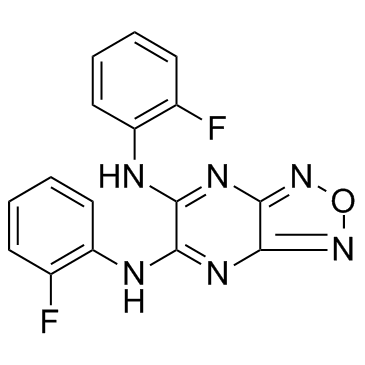| Description |
BAM 15 is a novel mitochondrial protonophore uncoupler.
|
| Related Catalog |
|
| In Vitro |
BAM 15 is able to increase O2 consumption across a broad dosing range without increasing ROS. BAM 15 and FCCP are structurally unrelated and it is observed that low doses of BAM 15 from 100 nM to 1 μM increase cellular O2 consumption rate (OCR) to a similar degree as FCCP, but higher concentrations from 1 μM to 50 μM reveal that BAM 15 is able to maintain uncoupled respiration at a high rate in a range of cell lines. BAM 15 is fully capable of increasing mitochondrial respiration in the presence of oligomycin and does so across a broader concentration range than FCCP in both myoblasts and hepatocytes. BAM 15 induces mitochondrial swelling, demonstrating that BAM 15 is a protonophore. BAM15-treated cells are more viable than FCCP-treated cells when administered across a broad dosing range up to 50 μM[1].
|
| In Vivo |
Compare to vehicle-treated mice, animals that receive BAM 15 are protected from kidney injury as indicated by lower plasma creatinine levels at 24 and 48 h post-ischemia, reduced tubular necrosis, less depletion of brush border villi, less obstruction of proximal tubules, and less immune cell infiltration[1].
|
| Kinase Assay |
Electron flow assays are performed. Briefly, 5 μg of mitochondrial protein in MAS is loaded into a 24-well tissue culture plate and centrifuged at 2000×g for 15 min at 4°C. Prior to the assay, mitochondria are incubated at 37°C for 10 mins in MAS containing 10 mM pyruvate, 2 mM malate, and 5 μM BAM 15 or FCCP. Rotenone (2 μM), succinate (10 mM), antimycin A (4 μM), and N,N,N′,N′-tetramethyl-p-phenylenediamine (TMPD, 100 μM) plus ascorbate (10 mM) are added sequentially as indicated in the figure. N=3 wells/plate of a representative of 3 plates[1].
|
| Cell Assay |
L6 cells are incubated with the fluorescent indicator of mitochondrial membrane potential tetramethylrhodamine (TMRM, 125 nM) or DMSO (1%) control for 30 min. The cells are then centrifuged for 5 min at 700×g and resuspended in unbuffered DMEM at a concentration of 1×105 cells/mL. The cells are then treated with BAM 15 or DMSO (0.1%) for 10 min prior to flow cytometric analysis[1].
|
| Animal Admin |
Male mice (8-week old, C57BL/6) are anesthetized with a mixture (i.p.) of ketamine (120 mg/kg), xylazine (12 mg/kg), and atropine (0.324 mg/kg) and are subjected to bilateral ischemic reperfusion injury (26 min ischemia, then 24 h or 48 h reperfusion). During the surgery, mouse core temperature is maintained at 34 to 36°C with a heating pad; during the recovery and reperfusion period, mice are housed in a warming incubator with ambient temperature at 30 to 32 °C. Control, sham-operated mice undergo a similar procedure, but the renal pedicles are not clamped. Mice are i.p. injected with BAM 15 at 1 or 5 mg/kg, 1 h before kidney IR. Vehicle mice are also injected with the same solution BAM 15 is prepared with (3% DMSO in 50% PEG400)[1].
|
| References |
[1]. Kenwood BM, et al. Identification of a novel mitochondrial uncoupler that does not depolarize the plasma membrane. Mol Metab. 2013 Nov 28;3(2):114-23.
|
